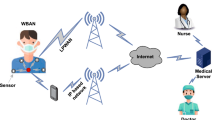Abstract
The rapid demand for technologies gradually increases to provide solutions to people suffering from chronic diseases. These technologies also practice continuous health monitoring of patients for early intervention and prevention. Additionally, there is also a need for the interoperation of different connected devices and application services in smart health care. Among these technologies, a wireless body area network (WBAN) is an appropriate option to monitor people’s health remotely. However, existing systems have limitations of high energy dissipation in processing the data. This article aims to provide a system that collaborates to leverage the advantages of the Internet of Things (IoT)’s LoRa technology, Mobile Ad hoc network (MANET) systems, and data aggregation schemes to conserve the energy in transmitting packets. Our proposed model optimizes and reduces energy dissipation in the network compared to existing models. It also presents a novel approach for the early detection of urgent biosignals.
Access this chapter
Tax calculation will be finalised at checkout
Purchases are for personal use only
Similar content being viewed by others
References
Boikanyo K, Zungeru AM, Sigweni B, Yahya A, Lebekwe C (2023) Remote patient monitoring systems: applications, architecture, and challenges. Sci African 01638
Silverio-Fernandez MA, Renukappa S, Suresh S (2019) Evaluating critical success factors for implementing smart devices in the construction industry: an empirical study in the Dominican republic. Eng Construct Arch Manage
Lee I, Lee K (2015) The internet of things (IoT): applications, investments, and challenges for enterprises. Business Horizons 58(4):431–440
Balandina E, Balandin S, Koucheryavy Y, Mouromtsev D (2015) IoT use cases in healthcare and tourism. In: 2015 IEEE 17th Conference on business informatics, Vol 2. IEEE, pp 37–44
Mustafa T, Varol A (2020) Review of the internet of things for healthcare monitoring. In: 2020 8th International symposium on digital forensics and security (ISDFS). IEEE, pp 1–6
Baker SB, Xiang W, Atkinson I (2017) Internet of things for smart healthcare: technologies, challenges, and opportunities. IEEE Access 5:26521–26544
Zou N, Liang S, He D (2020) Issues and challenges of user and data interaction in healthcare-related IoT: a systematic review. Library Hi Tech
Gupta S, Snigdh I (2022) An energy-efficient information-centric model for internet of things applications. In: 2022 International conference on IoT and blockchain technology (ICIBT). IEEE, pp 1–5
Mohapatro M, Snigdh I (2020) Security in IoT healthcare. In: IoT security paradigms and applications. CRC Press, pp 237–259
Abiodun AS, Anisi MH, Khan MK (2019) Cloud-based wireless body area networks: managing data for better health care. IEEE Cons Electron Magaz 8(3):55–59
Abiodun AS, Anisi MH, Ali I, Akhunzada A, Khan MK (2017) Reducing power consumption in wireless body area networks: a novel data segregation and classification technique. IEEE Consum Electron Magaz 6(4):38–47
Almashaqbeh G, Hayajneh T, Vasilakos AV, Mohd BJ (2014) Qos-aware health monitoring system using cloud-based WBANs. J Med Syst 38(10):1–20
Fortino G, Galzarano S, Gravina R, Li W (2015) A framework for collaborative computing and multi-sensor data fusion in body sensor networks. Inform Fusion 22:50–70
Gupta S, Snigdh I (2022) Leveraging data aggregation algorithm in loRa networks. J Super Comput 1–15 (2022)
Gupta S, Snigdh I (2021) Analyzing impacts of energy dissipation on scalable IoT architectures for smart grid applications. In: Advances in smart grid automation and industry 4.0. Springer, pp 81–89
Gupta S, Snigdh I (2023) Applying bayesian belief in loRa: smart parking case study. J Amb Intell Human Comput 1–14
Gupta S, Snigdh I, Sahana SK (2022) A fuzzy logic approach for predicting efficient loRa communication. Int J Fuzzy Syst 1–9
Mohapatro M, Snigdh I (2021) An experimental study of distributed denial of service and sink hole attacks on IoT based healthcare applications. Wireless Pers Commun 121:707–724
Parlitz U, Berg S, Luther S, Schirdewan A, Kurths J, Wessel N (2012) Classifying cardiac biosignals using ordinal pattern statistics and symbolic dynamics. Comp Biol Med 42(3):319–327
Gupta S, Singh U (2021) Ontology-based IoT healthcare systems (IHS) for senior citizens. Int J Big Data Anal Healthcare (IJBDAH) 6(2):1–17
Alliance L (2015) A technical overview of loRa and loRaWAN. White Paper, November 20
Gupta U, Pantola D, Bhardwaj A, Singh SP (2022) Next-generation networks enabled technologies: challenges and applications. Next Gener Commun Netw Indust Internet of Things Syst 191–216
Soni G, Gupta U, Singh N (2014) Analysis of modified substitution encryption techniques
Bruzgiene R, Narbutaite L, Adomkus T (2017) Manet network in internet of things system. Ad hoc Netw 66:89–114
Bellavista P, Cardone G, Corradi A, Foschini L (2013) Convergence of manet and WSN in IoT urban scenarios. IEEE Sens J 13(10):3558–3567
Gupta P, Tripathi S, Singh S (2021) Energy-efficient routing protocols for cluster-based heterogeneous wireless sensor network (HETWSN)-strategies and challenges: a review. Data Anal Manage Proc ICDAM 853–878
Bor MC, Roedig U, Voigt T, Alonso JM (2016) Do loRa low-power wide-area networks scale? In: Proceedings of the 19th ACM international conference on modeling, analysis and simulation of wireless and mobile systems, pp 59–67. https://doi.org/10.1145/2988287.2989163
Author information
Authors and Affiliations
Corresponding author
Editor information
Editors and Affiliations
Rights and permissions
Copyright information
© 2024 The Author(s), under exclusive license to Springer Nature Singapore Pte Ltd.
About this paper
Cite this paper
Gupta, S., Manorama, Snigdh, I. (2024). An Energy Conserving MANET-LoRa Architecture for Wireless Body Area Network. In: Swaroop, A., Polkowski, Z., Correia, S.D., Virdee, B. (eds) Proceedings of Data Analytics and Management. ICDAM 2023. Lecture Notes in Networks and Systems, vol 785. Springer, Singapore. https://doi.org/10.1007/978-981-99-6544-1_45
Download citation
DOI: https://doi.org/10.1007/978-981-99-6544-1_45
Published:
Publisher Name: Springer, Singapore
Print ISBN: 978-981-99-6543-4
Online ISBN: 978-981-99-6544-1
eBook Packages: Intelligent Technologies and RoboticsIntelligent Technologies and Robotics (R0)




